

De Rosa: The Art of The Artisan - Part 2
By Cyclingnews Staff in Loria, Italy
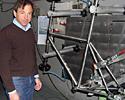 |
The Manufacturing process
First stop on the tour with Cristiano of the De Rosa factory was the special "reparto titanio" where his brother Doriano builds each De Rosa Titanium frame. "We've been building titanium frames in-house since 1990," explained Cristiano, "and now we've modified the frame to include an integrated headset."
De Rosa offers their Titanio in both traditional geometry and the Titanio x.s. version with sloping geometry.
King head tube
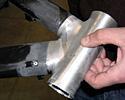 |
"One unique feature of the King," Cristiano told us, "is that with the aluminium lugs, we can offer a custom frame. That is the key part of our artisan approach." With the integrated aluminium head and seat lugs and bottom bracket, each De Rosa King can be fit to the individual rider and offer that personalized ride that De Rosa is rightfully famous for.
King tubes
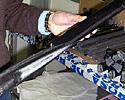 |
"This downtube has a unique shape that was the result of over a year of development here in Italy, and in cooperation with Mizuno in Japan, the world's number one company for development of carbon fibre for sporting goods applications," said Cristiano.
King test bed
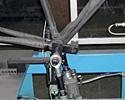 |
"Before we launched the King frame," said Cristiano De Rosa, "we did a lot of testing to understand just how to derive the best combination of carbon fibre composition and shape. Not only do we have our crew of road testers, but this custom built test bed machine really enabled us to refine the King."
Aerospace glue
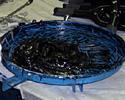 |
"First we have to mix up this special aerospace glue," explained Cristiano in the special dust-free, temperature controlled isolation room where the "incollagio" or bonding of the aluminium front triangle of the Dual is joined to the carbon fibre rear triangle. "We call it Dual because this bike is made from two materials: aluminium and carbon fibre," said De Rosa.
Incollagio stage1
 |
Once the glue is mixed and the completed front triangle is checked for its special undercoating, the aerospace adhesive is carefully spread throughout the key points where carbon fibre will mate with aluminium.
Incollagio stage 2
The De Rosa Dual's rear chainstays, complete with dropouts, have been inserted into the monobox, awaiting seatstay bonding.
Incollagio stage 3
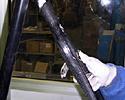 |
Now the seatstays have been coated with aerospace adhesive and the wishbone inserted into the De Rosa Dual's rear seat cluster section.
Incollagio stage 4
Before the frame goes into the oven for the final binding, the staff member responsible for adhesives cleans off the De Rosa Dual frame of excess bonding material that might adhere to the outside.
Incollagio stage 5
Just brown and serve... Well not quite! This De Rosa Dual is ready for the final phase of the bonding operation inside De Rosa's purpose built oven.
Oven De Rosa Dual
 |
De Rosa Dual frames are baked in the oven to seal and cure the aerospace adhesive that bonds the carbon fibre rear triangle to the U2 aluminium front triangle. The Dual cooks for about an hour at a temperature around 90 degrees centigrade, although Cristiano told us that the actual figures are secret.
CNC Fresatura
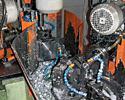 |
Although this milling machine looks like a mess, it is for a good reason, explained Cristiano. "We have been really busy this month with production and custom builds," he said. "Each frame must have the tubes mitred precisely depending on the size, angles, etcetera, so that's what this special CNC milling tool does. When we make the welds, the tube joins are 100 percent exact and precise."
Danilo welding
 |
The eldest De Rosa brother, Danilo, is a chip off the old block. He has inherited his father Ugo's masters touch with the welding torch. "We used to come here every day after school to help out our dad," explained Cristiano. "We did all the various things in the shop: filing; cleaning up; packing... then our dad taught us how to build bikes." Cristiano did not seem to have exactly the same gifts as his two brothers when it came to bike building technique, but his commercial skills and diplomatic aplomb as the ambassador for De Rosa, make up for any shortcomings with a welding torch or a file.
Custom titanium
 |
"Our titanium frames are custom built," said Cristiano as we looked at the schematic drawing for another De Rosa Titanio frame. In fact, when you look in the De Rosa catalogue to check, the Titanio section only indicates custom sizes. De Rosa dealers send the rider's measurements to De Rosa, where Doriano creates a specific schematic drawing so each De Rosa Titanio frame built is unique.
Classic De Rosa Bikes
 |
Roman Vainstein's De Rosa Merak
Still bearing the road dirt of Brittany, and number 223 indicating the Latvian team did not exactly get a great start position at the 2000 World Pro Road Championships in Plouay, France, here is eventual winner Roman Vainstein's De Rosa Merak.
1994 Titano
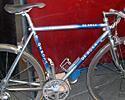 |
For a short time, Russian Evgeni Berzin was the hottest rider on Earth. In 1994, the classy blond Berzin won Liege-Bastogne-Liege in front of Lance Armstrong, then went on to kick Marco Pantani's and Miguel Indurain's rears in the Giro d'Italia a month later. Who could ever forget the raging Russian in his fabulous win in the Stage 8 time trial from Grosetto to Follonica, run at an average speed of over 52km/h?
Although Berzin, and his fellow Russian Gewiss teammate Vladislav Bobrik (winner of the '94 Giro di Lombardia), were so familiar to American cycling fans from their Tour Du Pont exploits, neither rider ever quite went on to fulfil their potential, but they both rode De Rosas to big wins. Here is Berzin's 1994 De Rosa Titano from the Giro d'Italia.
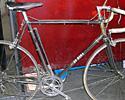 |
1959 De Rosa
Part of the 100 Years Of Racing exhibit, we snapped this '59 De Rosa before Ugo could clean off the dust from the officina. Note the trademark square fork crown and clean modern lines that have always been the hallmark of De Rosa bicycles.
Cristiano and the Corum Composite
 |
After our in-depth and highly informative tour at De Rosa was almost concluded, Cristiano showed us one last bike in De Rosa's range: Corum Composite. "We introduced this model at the Milano show last year and think it will be interesting to Cyclingnews readers," said De Rosa. "We have mated a full carbon rear triangle with a lightweight Dedaccai steel front triangle. It has a very special ride and is one of our most unique models."
Visit De Rosa's Web site.
Photos
Images by Tim Maloney/Cyclingnews
- Not so easy to find, De Rosa's showroom and production facility is hidden in an industrial zone
- "We've been building Ti frames in-house since 1990," explained Cristiano
- Roman Vainstein's De Rosa Merak
- Russian Evgeni Berzin's 1994 Titano
- 59 De Rosa, Part of the 100 Years Of Racing exhibit
- Aluminium lugs allow De Rosa to easily build custom frames
- This downtube has a unique shape that was the result of over a year of development
- The parts of a King, pre-gluing
- "This custom built test bed machine really enabled us to refine the King."
- A finished De Rosa King frame
- The "special aerospace glue" used to bond the carbon together
- Applying the "special glue" to the lugs
- The De Rosa Dual's rear chainstays awaiting seatstay bonding.
- Now the seatstays have been coated with aerospace adhesive and the wishbone inserted into the De Rosa Dual's rear seat cluster section
- Cleaning off the excess bonding material
- This De Rosa Dual is ready for the final phase of the bonding operation inside De Rosa's purpose built oven.
- De Rosa Dual frames are baked in the oven to seal and cure the aerospace adhesive that bonds the carbon fibre rear triangle to the U2 aluminium front triangle
- Although this milling machine looks like a mess, it is for a good reason
- The eldest De Rosa brother, Danilo, is a chip off the old block
- "Our titanium frames are custom built," said Cristiano
- De Rosa's Corum Composite